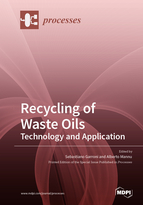Recycling of Waste Oils: Technology and Application
A special issue of Processes (ISSN 2227-9717). This special issue belongs to the section "Environmental and Green Processes".
Deadline for manuscript submissions: closed (30 September 2020) | Viewed by 55451
Special Issue Editors
Interests: piezoceramics; structural characterization; wet chemistry; processing
Special Issues, Collections and Topics in MDPI journals
Interests: chemical fingerprints; multivariate analysis; design of experiments; and quality assessment
Special Issues, Collections and Topics in MDPI journals
Special Issue Information
Dear Colleagues,
We are currently facing important challenges in many aspects of our life, from food demand to energy production and from exploitability of resources to climate change. We can observe as general trend in modern industry in the reconversion of existing processes and the design of new ones on the basis of the circular economy concept. In such a vision, wastes upon production can be considered raw materials for other processes. In order to produce sensible advances toward a global circular economy, the scientific research and the consequent technological advances must be directed on the concept of recycling of byproducts in a sustainable way. In such a panorama, waste oils represent a major challenge. In fact, they are produced worldwide in huge amounts and they are responsible for many environmental issues if not properly disposed of. At the same time, their chemical composition, constituting a mixture of fatty acids, makes them an important raw material for many industrial processes. For all these reasons, the recycling of waste oils is currently mandatory in many countries and is matter of discussion in many others.
This Special Issue entitled “Recycling of Waste Oils: Technology and Application” is aimed to cover the current advances on waste oils recycling in terms of technological solutions, sustainability aspects, and application of waste oils as raw material. Topics include but are not limited to:
- Waste oils production and disposal.
- Vegetal used oils recycling.
- Mineral oils recycling.
- Technological advances in waste oil recycling.
- Economic, marketing, and legislative aspects related with waste oils’ life cycle.
Dr. Alberto Mannu
Dr. Sebastiano Garroni
Guest Editors
Manuscript Submission Information
Manuscripts should be submitted online at www.mdpi.com by registering and logging in to this website. Once you are registered, click here to go to the submission form. Manuscripts can be submitted until the deadline. All submissions that pass pre-check are peer-reviewed. Accepted papers will be published continuously in the journal (as soon as accepted) and will be listed together on the special issue website. Research articles, review articles as well as short communications are invited. For planned papers, a title and short abstract (about 100 words) can be sent to the Editorial Office for announcement on this website.
Submitted manuscripts should not have been published previously, nor be under consideration for publication elsewhere (except conference proceedings papers). All manuscripts are thoroughly refereed through a single-blind peer-review process. A guide for authors and other relevant information for submission of manuscripts is available on the Instructions for Authors page. Processes is an international peer-reviewed open access monthly journal published by MDPI.
Please visit the Instructions for Authors page before submitting a manuscript. The Article Processing Charge (APC) for publication in this open access journal is 2400 CHF (Swiss Francs). Submitted papers should be well formatted and use good English. Authors may use MDPI's English editing service prior to publication or during author revisions.
Keywords
- Waste oil processing
- Waste oil recycling
- Waste oil application
- Waste oil characterization
- Materials from waste oils
- Materials for waste oil recycling
- Lubricants
- Biofuels
- Bioplastics







